Latest News
Featuring stories and mentions of CrowdHydrology in the local, regional and national press. All press inquiries should be directed to Dr. Christopher Lowry.
Featuring stories and mentions of CrowdHydrology in the local, regional and national press. All press inquiries should be directed to Dr. Christopher Lowry.
Taking scientific measures: Public can help research project by submitting refuge gauge data
Technology is increasing opportunities for crowdsourcing water data. CrowdHydrology, a new phone application that debuted at the American Geophysical Union meeting in Dec. 2014, allows citizen scientists to report stream depths at various gauging stations and is run in partnership with the U.S. Geological Survey. The stations have signs asking people to report the stream depth by phone. When using the app, the location, time, and data are reported automatically.
http://stormwater.wef.org/2015/02/crowdsourcing-water-data/
Full article: http://www.geolsoc.org.uk/Geoscientist/Archive/August-2014/Crowdsourcing-science
Fast Co. Article by Zac Stone
Crowd Hydrology—which started with just a ruler in a stream and a request to passersby to record the height—uses simple text messages to take measurements where the government can no longer afford to send people.
Full article: http://www.fastcoexist.com/1682571/an-army-of-citizen-scientists-is-tracking-our-water-levels
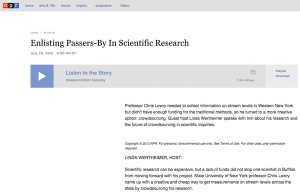 CrowdHydrology’s biggest feature yet, the Morning Edition show on National Public Radio.
CrowdHydrology’s biggest feature yet, the Morning Edition show on National Public Radio.
Professor Chris Lowry needed to collect information on stream levels in Western New York but didn’t have enough funding for the traditional methods, so he turned to a more creative option: crowdsourcing. Guest host Linda Wertheimer speaks with him about his research and the future of crowdsourcing in scientific inquiries.
Full article: Enlisting Passers-by in Scientific Research
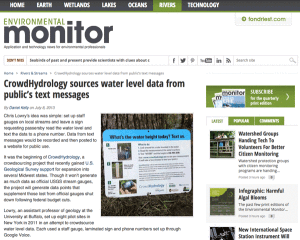 CrowdHydrology noticed by industry publication, Environmental Monitor.
CrowdHydrology noticed by industry publication, Environmental Monitor.
Chris Lowry’s idea was simple: set up staff gauges on local streams and leave a sign requesting passersby read the water level and text the data to a phone number. Data from text messages would be recorded and then posted to a website for public use.
It was the beginning of CrowdHydrology, a crowdsourcing project that recently gained U.S. Geological Survey support for expansion into several Midwest states. Though it won’t generate as much data as official USGS stream gauges, the project will generate data points that supplement those lost from official gauges shut down following federal budget cuts.
Full article: CrowdHydrology sources water level data from public’s text messages
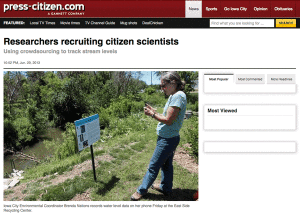 CrowdHydrology featured in the Iowa City Press-Citizen.
CrowdHydrology featured in the Iowa City Press-Citizen.
A University of Iowa researcher is hoping that the same tactic that sustains Wikipedia and helps trendy businesses think up new designs and campaigns will help him collect water level data.
UI assistant geoscience professor Adam Ward is turning to crowdsourcing to collect data on three points in Johnson County. He’s installed three stream gauges – which basically are rulers in the water with signs explaining their purpose – from which he wants passersby to text the water levels to a phone number that automatically uploads them to an online database.
Full article: Researchers recruiting citizen scientists
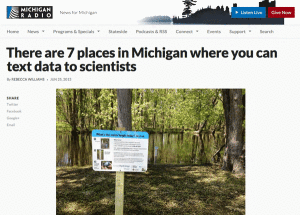 CrowdHydrology was mentioned on Michigan Public Radio, during a segment of the Environmental Report.
CrowdHydrology was mentioned on Michigan Public Radio, during a segment of the Environmental Report.
If you’ve ever wanted to get involved in science but thought it sounded like a lot of work, now all you have to do is send a text.
Chris Lowry is an assistant professor of geology at the University at Buffalo. He’s the co-creator of CrowdHydrology. You can think of it as crowdsourcing information about water.
“So basically how this works is we have some giant rulers that are set up in streams and there’s a little sign on the top of the ruler that says ‘please text us the water level’ and people who are walking by these signs with their mobile phones can look at the ruler and make a measurement off that ruler of what the water level would be at that particular time of the day and send us a text message,” he says.
Full article: 7 places in Michigan where you can text data to scientists
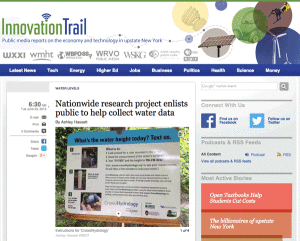 CrowdHydrology featured on website Innovation Trail for efforts in Upstate New York.
CrowdHydrology featured on website Innovation Trail for efforts in Upstate New York.
Mobile technology has created some new opportunities for citizen scientists to play an active part in research, especially with tighter budgets. Now a nationwide project is enlisting the public to gather up-to-date information on water levels.
If you walk through the trails of Tifft Nature Preserve on the edge of Lake Erie you will see a sheltered information sign in front of a small lake that says “What’s the water height today? Text us.” UB Assistant Professor Chris Lowry explains.
Full article: Nationwide research project enlists public to help collect water data